英国文学之莎士比亚的哈姆莱特Shakespeares Hamlet
《哈姆雷特》著名作家莎士比亚的一部悲惨作品

《哈姆雷特》著名作家莎士比亚的一部悲惨作品《哈姆雷特(Hamlet)》是由威廉·莎士比亚创作于1599年至1602年间的一部悲剧作品。
该剧的剧情是通过三条线索展开的。
接下来小编给大家分享一篇关于著名作家莎士比书写哈姆雷特的故事吧。
哈莫雷特第一幕第一场艾尔西诺。
城堡前的露台弗兰西斯科立台上守望。
勃那多自对面上。
勃那多那边是谁?弗兰西斯科不,你先回答我;站住,告诉我你是什么人。
勃那多国王万岁!弗兰西斯科勃那多吗?勃那多正是。
弗兰西斯科你来得很准时。
勃那多现在已经打过十二点钟;你去睡吧,弗兰西斯科。
弗兰西斯科谢谢你来替我;天冷得厉害,我心里也老大不舒服。
勃那多你守在这儿,一切都很安静吗?弗兰西斯科一只小老鼠也不见走动。
勃那多好,晚安!要是你碰见霍拉旭和马西勒斯,我的守夜的伙伴们,就叫他们赶紧来。
弗兰西斯科我想我听见了他们的声音。
喂,站住!你是谁?霍拉旭及马西勒斯上。
霍拉旭都是自己人。
马西勒斯丹麦王的臣民。
弗兰西斯科祝你们晚安!马西勒斯啊!再会,正直的军人!谁替了你?弗兰西斯科勃那多接我的班。
祝你们晚安!(下。
)马西勒斯喂!勃那多!勃那多喂,——啊!霍拉旭也来了吗?霍拉旭有这么一个他。
勃那多欢迎,霍拉旭!欢迎,好马西勒斯!马西勒斯什么!这东西今晚又出现过了吗?勃那多我还没有瞧见什么。
马西勒斯霍拉旭说那不过是我们的幻想。
我告诉他我们已经两次看见过这一个可怕的怪象,他总是不肯相信;所以我请他今晚也来陪我们守一夜,要是这鬼魂再出来,就可以证明我们并没有看错,还可以叫他和它说几句话。
霍拉旭嘿,嘿,它不会出现的。
勃那多先请坐下;虽然你一定不肯相信我们的故事,我们还是要把我们这两夜来所看见的情形再向你絮叨一遍。
霍拉旭好,我们坐下来,听听勃那多怎么说。
勃那多昨天晚上,北极星西面的那颗星已经移到了它现在吐射光辉的地方,时钟刚敲了一点,马西勒斯跟我两个人——马西勒斯住声!不要说下去;瞧,它又来了!鬼魂上。
勃那多正像已故的国王的模样。
哈姆莱特主要内容

哈姆莱特主要内容哈姆雷特是莎士比亚史上最著名的悲剧之一,也被誉为最伟大的戏剧作品之一。
它描述了英国国王哈姆雷特在自卑、怨恨、暴徒、政治势力和家族利益等不利因素的影响下的悲剧命运,以及维持社会秩序和正义的可能政治策略。
故事以英国威尔士山脉的Denmark为背景,讲述了哈姆雷特的故事:哈姆雷特(Hamlet)是贵族家庭的长子,他的父亲,国王,在休息室里被他的弟弟谋杀了。
弟弟取代了他父亲的王位,而哈姆雷特的母亲却与他的弟弟结婚。
在继承人的安排中,哈姆雷特被排除在外,从而触发了他的报复心理。
哈姆雷特知道他的叔叔残忍地杀害了他的父亲,他内心的恨意便开始滋生,他的内心深处发出一个新的声音:维护正义,报仇雪耻。
然而,他最终放弃了报复的念头:他不愿意以一个真正无辜的人付出代价。
他希望找到一种更好的方式,如何将坏人绳之于法,并以公正的手段维护家族和社会的正义。
故事引发了更深层次的思考:在政治权力和道德责任互相矛盾的情况下,奋起保护家庭和社会公正的人,究竟能做些什么?哈姆雷特最终采取了“正义”手段的行动,即杀掉叔叔并掉以轻心的政治处理,但是他的做法会造成什么后果?故事结尾没有给出确切的答案,而是让人们深刻地思考:在政治变革中,如何在维护正义的同时也不伤害无辜的人?如何在追求改变的同时保持考虑周全的行为?如何真正做到把政治权力和道德责任相结合?这些深刻的思想和主题,使哈姆雷特保持着浓厚的思想和情感,一代代传承下来,成为经典。
总之,哈姆雷特有着穿越时代的长久影响力,它的深刻思想和传奇故事,令人深思,是世界戏剧史上最值得珍藏的经典之作。
它也是一部批判性的政治和道德史诗,以其历久弥新的意义和解释,鼓舞了无数读者和剧迷们,激发了深刻的思想和情感,一直延续至今。
双语阅读《哈姆雷特》节选
双语阅读《哈姆雷特》节选双语阅读《哈姆雷特》节选《哈姆雷特(Hamlet)》是由英国剧作家威廉·莎士比亚创作于1599年至1602年间的一部悲剧作品。
以下是应届毕业生网店铺为大家推荐的双语阅读《哈姆雷特》节选,希望大家喜欢。
Hamlet is one of Shakespeare’s great tragedies and possibly the most mis-quoted. It deals with the psychological torment of a young Danish prince, Hamlet himself, who is racked with murderous intent. Hamlet’s Father, the King of Denmark, is dead and the Ki ng’s brother (Hamlet’s uncle), Claudius, has married the widowed Queen, Gertrude. Hamlet is disgusted and cannot bear that his mother has betrayed his father’s memory in what he considers to be an incestuous manner. When the ghost of the dead King appears to Hamlet and fills him with a powerful desire for revenge, Hamlet becomes more and more desperate to destroy Claudius and avenge his father’s memory. However, despite this desire to kill his stepfather, Hamlet struggles to achieve his purpose and a series of disastrous events ensue. He mistreats his Love, Ophelia, who is so distraught by the change in Hamlet’s manner towards her that she is driven to insanity, the beautiful yet tormented soliloquies engaged in by Hamlet become increasingly desperate as Ham let’s rage and despair strengthen, and Gertrude’s belief that Hamlet is mad with grief is apparent when Gertrude and Hamlet Speak together in Act IV. Hamlet is Shakespeare’s greatest tragic hero and, while the end of the Play is inevitable, the unravelling of the story is a wonder. Each scene is rendered in words of poetic beauty that simultaneously delight and horrify. The play is still as relevant today as it was when it was first written and performed as societyis still troubled with political intrigue and deception, the hunt for bloody revenge, the tortures of a doomed love, and the cruelty of bereavement and loss. It is because Shakespeare speaks for humanity as a whole that makes Hamlet, like so many of his plays, universal. Hamlet is not bound by its time but transcends this boundary to speak to people just as powerfully as it did four hundred years ago.哈姆雷特王子是最近突然驾崩的丹麦王哈姆雷特与皇后葛楚德的儿子。
简述莎士比亚的悲剧《哈姆莱特》的艺术特征
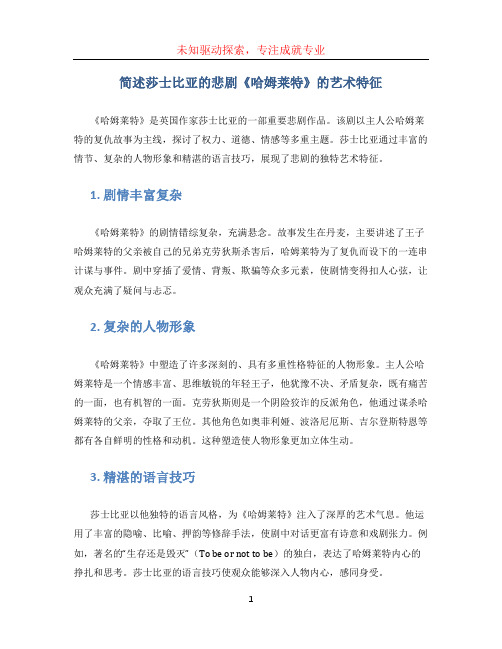
简述莎士比亚的悲剧《哈姆莱特》的艺术特征《哈姆莱特》是英国作家莎士比亚的一部重要悲剧作品。
该剧以主人公哈姆莱特的复仇故事为主线,探讨了权力、道德、情感等多重主题。
莎士比亚通过丰富的情节、复杂的人物形象和精湛的语言技巧,展现了悲剧的独特艺术特征。
1. 剧情丰富复杂《哈姆莱特》的剧情错综复杂,充满悬念。
故事发生在丹麦,主要讲述了王子哈姆莱特的父亲被自己的兄弟克劳狄斯杀害后,哈姆莱特为了复仇而设下的一连串计谋与事件。
剧中穿插了爱情、背叛、欺骗等众多元素,使剧情变得扣人心弦,让观众充满了疑问与忐忑。
2. 复杂的人物形象《哈姆莱特》中塑造了许多深刻的、具有多重性格特征的人物形象。
主人公哈姆莱特是一个情感丰富、思维敏锐的年轻王子,他犹豫不决、矛盾复杂,既有痛苦的一面,也有机智的一面。
克劳狄斯则是一个阴险狡诈的反派角色,他通过谋杀哈姆莱特的父亲,夺取了王位。
其他角色如奥菲利娅、波洛尼厄斯、吉尔登斯特恩等都有各自鲜明的性格和动机。
这种塑造使人物形象更加立体生动。
3. 精湛的语言技巧莎士比亚以他独特的语言风格,为《哈姆莱特》注入了深厚的艺术气息。
他运用了丰富的隐喻、比喻、押韵等修辞手法,使剧中对话更富有诗意和戏剧张力。
例如,著名的“生存还是毁灭”(To be or not to be)的独白,表达了哈姆莱特内心的挣扎和思考。
莎士比亚的语言技巧使观众能够深入人物内心,感同身受。
4. 深刻探讨权力和道德《哈姆莱特》通过探讨权力和道德的问题,展示了人性的复杂性和道德的多样性。
克劳狄斯夺取王位的行为暴露了权力的滥用和背叛的阴谋。
哈姆莱特一直犹豫不决的行为也引发了对人性内在的思考。
剧中的人物无一不受到欲望、抱负和情感的驱使,他们的选择与决定也因个体的情感和信仰不同而产生差异。
这种探讨使《哈姆莱特》超越了单纯的复仇故事,赋予了剧作更深刻的内涵。
总结起来,《哈姆莱特》作为莎士比亚的悲剧作品,在剧情的丰富复杂、人物形象的多重性格、精湛的语言技巧以及对权力和道德的深刻探讨等方面,展现了独特的艺术特征。
Shakespeare's Hamlet 莎士比亚 《哈姆雷特》
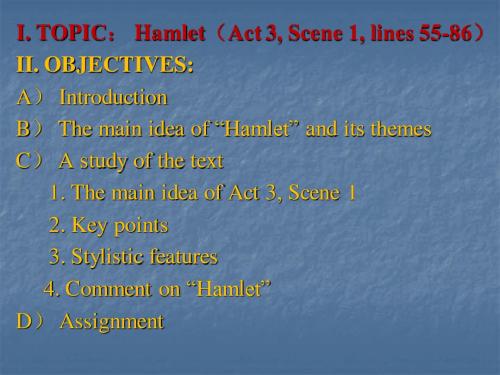
When Hamlet returned home , he learned of Ophelia's death. Ophelia's brother Laertes requested to fight with Hamlet. Claudius arranged a fencing match for them . And he attempted to let Laertes kill Hamlet with a poisoned sword. In the match, Hamlet was hit with the poisoned sword. Laertes was also wounded badly. The Queen drank the poisoned wine for Hamlet and warned Hamlet that the drink was poisoned. And Laertes also told the whole truth to Hamlet before he died. In the end , Hamlet killed Claudius, at last avenging his father's death. Then Hamlet died as well.
【赏析】莎士比亚《哈姆莱特》

【赏析】莎士比亚《哈姆莱特》莎士比亚:《哈姆莱特》作品内容丹麦王子哈姆莱特本在德国威登堡大学念书,奔父丧回国,见叔父克劳狄斯登上王位,母后乔特露德匆匆改嫁新王,既疑又愤。
好友霍拉旭告知他,父王的鬼魂每天深夜出现在城堡露台。
他按时静候,果然见到亡魂。
倾听诉说后方知父王正是被叔父所害。
哈姆莱特悲愤异常,诅咒这万恶的时代,考虑到形势严峻,他决定装疯卖傻迷惑叔父及奸臣。
他的异常言行引起了克劳狄斯疑虑,便召来哈姆莱特的两个旧友探其真伪。
哈姆莱特忽庄忽谐,疯话间以哲理,使两位佞臣摸不着头脑。
大臣波洛涅斯向新王献策,认为让他的女儿奥菲利娅去约会哈姆莱特,他们可偷听这对恋人的谈话,必能弄清真相。
奸王依计而行,但依然不得要领。
哈姆莱特恐怕鬼魂之言不实,欲进一步证实克劳狄斯的罪行,便请戏班子来宫演剧,并约请克劳狄斯与母后及一干人等同来观剧。
因剧情与克劳狄斯所犯的罪行相仿,奸王心虚,不待剧终,便仓皇离去。
由此,你死我活的斗争真正开始。
克劳狄斯观剧受刺激后,独自在神像前忏悔,哈姆莱特正巧路过,本可一剑将其刺死,但虑及此举会将仇敌送入天堂,便放过了复仇机会,决定待其以后作孽时再动手。
他又来到了母后的寝宫,欲加以规劝,忽闻帷幕之后有动静,以为奸王在偷听便挺剑直刺,不料倒下的竟是邀功心切的波洛涅斯。
克劳狄斯闻知此事惊恐不安,找借口将哈姆莱特遣往英国,王子改写了随行者所带的密信,使两个卖友的小人代自己去英国受死,他则返回丹麦。
登岸后,遇见一个掘墓人一边干活一边在讽喻人生,哈姆莱特大受启发,宿命思想使他决心听天由命、静观其变。
克劳狄斯利用波洛涅斯之子雷欧提斯急于报父仇的心态,挑唆他与哈姆莱特决斗,并准备了毒剑毒酒。
决斗中,奸王假意祝贺哈姆莱特初战告捷,奉上毒酒,王后抢过喝下。
雷欧提斯违规下手,中剑的王子抢过毒剑还刺对手,雷欧提斯临死前揭发了克劳狄斯的阴谋,哈姆莱特在众人惊愕之际刺死罪恶累累的奸王,自己也毒发身亡。
他遗命由挪威王子福丁布拉斯继位。
莎士比亚四大悲剧概况(简短)

莎士比亚四大悲剧概况(简短)导语:《哈姆莱特》、《奥赛罗》、《李尔王》、《麦克白》是代表莎土比亚悲剧创作最高成就的“四大悲剧”,也是最淋漓地表现其伟大之处的作品,其中尤以《哈姆莱特》在世界上享誉最高,成为世界戏剧史上难以企及的高峰。
1、《哈姆雷特》(英语:Hamlet)又名《王子复仇记》,是莎士比亚的一部悲剧作品,著名悲剧之一,是他最负盛名和被人引用最多的剧本之一。
习惯上将本剧与《麦克白》、《李尔王》和《奥赛罗》一起,并称为莎士比亚的“四大悲剧”。
在《哈姆雷特》(Hamlet)中,复仇的故事中交织着爱恨情愁。
同时,哈姆雷特也是该剧主人公丹麦王子的名字。
后有据此改编的同名电影和越剧、京剧等艺术作品。
《哈姆雷特》在莎士比亚戏剧中是最长的一出,也是英国文学中最富震撼力、影响力的戏剧之一,并似乎“不停地被他人讲述、改编着。
”莎士比亚的《哈姆雷特》来自于阿姆雷特传奇(Amleth),出自十三世纪的萨克斯·格勒麦蒂克斯的作品《格斯塔·达诺拉姆》2、《奥赛罗》(Othello:TheMoorofVenice)是莎士比亚大约于1603年所写作的一出悲剧。
目前所知这出戏最早于1604年11月1日在伦敦的WhitehallPalace首演。
《奥赛罗》与《麦克白》、《李尔王》和《哈姆雷特》一起,并称为莎士比亚的“四大悲剧”。
奥赛罗是威尼斯公国一员勇将。
他与元老的女儿苔丝狄梦娜相爱。
但由于他是黑人,婚事未被允许。
两人只好私下成婚。
奥赛罗手下有一个*险的旗官伊阿古,一心想除掉奥赛罗。
他先是向元老告密,不料却促成了两人的婚事。
他又挑拨奥赛罗与苔丝狄梦娜的感情,说另一名副将凯西奥与苔丝狄梦娜关系不同寻常,并伪造了所谓定情信物等。
奥赛罗信以为真,在愤怒中掐死了自己的妻子。
当他得知真相后,悔恨之余拔剑自刎,倒在了苔丝狄梦娜身边。
3、《李尔王》(KingLear)是威廉·莎士比亚著名的悲剧之一,它可能于1605年写成,剧情基于一位传说中罗马人时代之前,不列颠国王李尔的故事,关于这位国王的史记、诗歌和剧作在莎士比亚时代前便已存在。
莎士比亚哈姆雷特主要内容

莎士比亚哈姆雷特主要内容《哈姆雷特》可不是个轻松的故事,真的是一部让人又想笑又想哭的戏。
要说起这个故事,得从丹麦王国的一个悲剧开始。
王国的老国王——哈姆雷特的爸爸,突然死了,大家都以为是生病死的,结果一场奇怪的事情发生了,哈姆雷特的叔叔,国王的弟弟——克劳狄斯,不仅坐上了王位,还迅速娶了哈姆雷特的妈妈——格特鲁德。
你能想象吗?自己的叔叔成了自己爸爸的继任者,而且还跟自己妈妈结婚了!哈姆雷特的心情自然很复杂了,既悲伤又愤怒,简直是脑袋里一锅粥。
而且这事还没完,就在哈姆雷特郁郁寡欢、心情烦躁的时候,他的父亲的幽灵竟然出现了!不是真的鬼魂,而是幽灵来找哈姆雷特诉说冤屈,说他是被自己的弟弟毒死的。
这下哈姆雷特更崩溃了,原来父亲死得那么不明不白,而且居然是自己亲叔叔干的。
你看看这戏剧性的展开,真的跟电视剧有得一拼,搞得哈姆雷特完全乱了阵脚。
哈姆雷特决定报仇,哪能让坏人得逞?可是呢,报仇这事儿可不是那么容易的,尤其是当你心里各种情绪交织的时候。
就像他脑袋里乱成一团麻,明明知道得做点什么,却偏偏不想行动。
他开始装疯卖傻,和身边的人都玩起了心理游戏。
比如,他开始对自己的母亲说一些很激烈的话,甚至还直接指责她“为啥这么快就跟爸爸的弟弟结婚?”他那么着急想知道真相,心里满是疑问,偏偏又不敢直接去找叔叔算账,生怕弄巧成拙。
所以他才选择了一种最愚蠢的办法——通过装疯来让周围的人都掉以轻心。
结果你猜怎么着?他的“疯癫”还真的吓到一堆人,甚至让他的朋友——霍拉旭都开始怀疑哈姆雷特到底是疯了,还是另有阴谋。
真是,这戏演得,观众都看得惊掉了下巴。
更有趣的是,哈姆雷特找来了几位演员,演了一出“父亲之死”的戏剧,通过戏中的场景来试探克劳狄斯的罪行。
天哪,简直就是一场现实中的大戏,谁能想到这场戏让哈姆雷特自个儿都陷得更深。
说实话,哈姆雷特的处境真的挺可怜的,犹豫不决的他,心里一团乱麻,外面的世界又这么让人不信任。
就算他拼命想要复仇,也总是犹豫不决,恍若一个正在自我挣扎的现代人,活得特别复杂。
莎士比亚及《哈姆雷特》
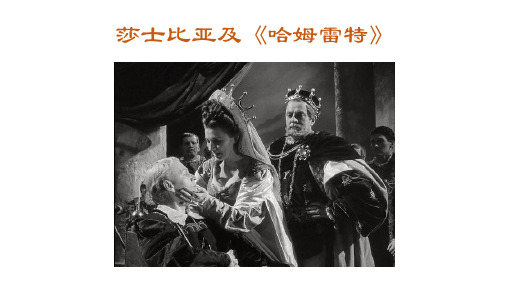
The Two Gentlemen of Verona Love's labour's lost Romeo and Juliet The Rape of Lucrece
理查二世
The life and death of King Richard Ⅱ
Much ado about nothing The merry wives of Windsor
The life of King Henry Ⅴ
裘力斯·凯撒(又译作朱利叶斯·凯撒)
the life and death of Julius Caesar
皆大欢喜 热情的朝圣者
As you like it The Passionate Pilgrim
乔特鲁德
丹麦王后,王子的亲生母亲。老哈姆雷特死后她改嫁克劳 狄斯,在莎士比亚的时代这种关系被视为乱伦,所以引起 了哈姆雷特的仇恨。她误喝下了克劳狄斯预设给哈姆雷特 的毒酒,当场身亡。 乔特鲁德对哈姆雷特影响甚大。哈姆雷特刚开始的痛苦更 多的不是因为父亲的过世(当时他不知道父亲是被谋杀), 更多的是因为他敬爱的母亲在他父亲刚去世就改嫁给了他 的叔父。乔特鲁德是一个并不知道什么是爱情的女人,她 需要的只是一个能给她安定生活的男人和她王后的地位。 她不爱先王,缺乏女子对爱情的忠贞,经不起诱惑,她只 能从外表上装出贤淑的样子来掩盖她对先王的背叛。而她 也是没有选择的选择,她没有独立生活和独立思考的能力, 也没有什么个人理由,她有的只是她的虚荣,她为了自己 的地位和宫廷的生活,为了自己的欲望伤害了自己的孩子, 直到死前她才醒悟。
创背景
十六、十七世纪之交,英国正处在封建制度向资本主义制度过渡时期,这个时期是英国历史进程中的一个巨大转折。 伊丽莎白统治的繁荣时期,资产阶级支持王权,而王权正好利用资产阶级,两方面不仅不对立,还结成了暂时的同 盟。由于政局比较稳定,社会生产力获得了迅速的发展。这种新兴资本主义生产关系的发展,虽然加速了封建社会 的崩溃,却仍然是依靠残酷地剥削农民来进行的。詹姆斯一世继位以后,专制集权被进一步推行,资产阶级和劳动 人民的反抗遭到了大肆镇压。社会矛盾进一步激化,它从根本上动摇了封建秩序,同时为十七世纪英国资产阶级革 命准备了条件,莎士比亚的创作正是对这个时代的艺术的深刻的反映。
高考名著阅读之《哈姆雷特》

高考名著阅读之《哈姆雷特》学问链接:《哈姆雷特》又名:王子报仇记。
作者:英国威廉•莎士比亚(William Shakespeare)《哈姆雷特》是莎士比亚最负盛名的剧本,同《麦克白》、《李尔王》和《奥赛罗》一起组成莎士比亚“四大悲剧”。
在《哈姆雷特》中,报仇的故事中交织着爱恨情愁。
同时,哈姆雷特也是该剧主子公丹麦王子的名字。
主要角色哈姆雷特Prince Hamlet ——丹麦王子。
为父王的鬼魂所困扰,要对杀父凶手报仇。
经验了苦痛的挣扎之后他达成了目的,整个王宫也陷入了死亡的恐怖之中。
他最终也中了致命的毒剑死去。
克劳地Claudius ——丹麦现任国王。
他是哈姆雷特的叔父,在哥哥死后继任了王位。
老王的鬼魂告知哈姆雷特,他正是谋杀自己的凶手。
他罪有应得,最终死在侄子报仇的毒剑下。
鬼魂King Hamlet (Ghost) ——哈姆雷特的父亲死后化成的鬼魂。
他被弟弟毒死时,哈姆雷特正在国外。
葛簇特Gertrude——丹麦王后,王子的亲生母亲。
老王死后她改嫁克劳地,在莎士比亚的时代这种关系被视为乱伦,所以引起了哈姆雷特的仇恨。
她替哈姆雷特误喝下了克劳地预设的毒酒,当场身亡。
波隆尼尔Polonius——克劳地的御前大臣。
他是个出了名的老顽固,阻挠哈姆雷特与欧菲莉亚之间的爱情。
哈姆雷特总是假装呆头呆脑来戏弄他。
他躲在一块挂毯后,偷听哈姆雷特与王后的谈话时,被王子一剑刺死。
雷尔提Laertes——波隆尼尔的儿子。
为了父亲和妹妹的死用剑杀死了哈姆雷特。
他也死在哈姆雷特的毒剑下,尽管当时哈姆雷特没有意识到剑是带毒的。
欧菲莉亚Ophelia——波隆尼尔的女儿。
她与哈姆雷特双双陷入爱河,但种种阻力警告王子,政治地位使他们无望结合。
作为哈姆雷特疯狂报仇支配的一部分,她被他无情抛弃,加上父亲的死让她陷入精神错乱,最终失足落水溺毙。
赫瑞修Horatio——哈姆雷特高校里的密友。
他没有干脆卷入王室之间的阴谋,所以他成了哈姆雷特的传声筒,莎翁用他来烘托剧情。
简述莎士比亚《哈姆莱特》的艺术成就

简述莎士比亚《哈姆莱特》的艺术成就
《哈姆莱特》是英国文艺复兴时期杰出的剧作家威廉·莎士比亚所创作的悲剧,被认为是全世界最伟大的文学之一。
它的艺术成就主要表现在以下几个方面:
1. 塑造具有深刻人物形象和独特个性的角色:莎士比亚塑造出丰满、鲜明、千姿百态、深刻的人物形象,其中最具有代表性的是“哈姆莱特”,他的个性深入人心,塑造了一个内心充满矛盾、经历命运的复杂性的人物形象。
舞台上的“哈姆莱特”可谓充满了嬉笑怒骂,展现了人性的复杂性和光辉。
2. 结合戏剧艺术和诗歌艺术:莎士比亚的《哈姆莱特》既是一部伟大的悲剧戏剧,又是一部优美的诗歌作品。
他将戏剧和诗歌融为一体,创造了一种独特的艺术形式。
他的诗句浑厚深沉,富有感情和情感,是世界文学中的瑰宝。
3. 揭示人类内心的复杂性和深度:《哈姆莱特》体现了莎士比亚丰富的人生经验和生命感悟,表现了人类内心的复杂性和深度,揭示了追求正义、真理以及个人自由与尊严的无穷无尽的渴望。
它深刻地反映了人生中的苦与乐、惊与喜、爱与恨,展示了人类精神的深度和宽广。
4. 引领了戏剧创作的一个新时代:《哈姆莱特》被认为是欧洲文艺复兴以来最具影响力的文学作品之一,它不仅在文学史上具有重大地位,在戏剧史上也是划时代的一部大作。
《哈姆莱特》所展现的剧作理念和技巧,在莎士比亚创作后的百年间一直在英国戏剧中占据着优势地位。
总之,莎士比亚的《哈姆莱特》以其复杂的人物形象、深入的思想、优美的语言、安排的戏剧结构和深刻的内涵,成为世界上最伟大的文学作品之一,并对全球文学和戏剧创作产生了深远的影响。
哈姆雷特作品简介

哈姆雷特作品简介
《哈姆雷特》是威廉·莎士比亚最具代表性的作品之一,被誉为英国文学传统中最杰
出的作品之一。
它是一部包含了世间万象、人类精神、家庭伦理、爱情、嫉妒、恐惧等元
素的悲剧。
本剧以丹麦王子哈姆雷特的悲剧命运为主线,展开了一幅荒诞离奇却又不乏深刻、严肃思考的精彩画卷。
故事背景:作品发生在丹麦王国,哈姆雷特的父亲被其叔叔克劳狄斯暗杀,并抢夺了
王位。
哈姆雷特因此丧失父亲和王位,母亲快速地嫁给了刚刚当上国王的克劳狄斯。
此时,哈姆雷特返家,发现父亲被克劳狄斯谋杀,开始了他的复仇计划,并在复仇过程中意外地
启发了关于真理、生命以及意义的诸多思考。
主要人物:哈姆雷特、克劳狄斯、奥菲莉亚、波罗尼斯、吉尔德文。
故事情节:整个故事充满了悬疑和秘密。
哈姆雷特走上了一条复仇之路,他在这一过
程中拟定了一种计划:利用一部剧本,让剧中的演员模仿刚刚发生的事情来揭示克劳狄斯
的罪行。
克劳狄斯在观看这出戏后感到内疚,于是决定毒杀哈姆雷特。
最终,哈姆雷特、
克劳狄斯、奥菲莉亚等人都死于剧情之中。
其他主题:除了复仇之外,本剧也涉及到许多其他的主题。
例如:人性中的善恶、伦
理和道德、人的自由意志、爱和亲情以及生命与死亡等。
售票:本剧在莎士比亚创作时期已经广受欢迎,后来一直被认为是莎士比亚最杰出的
作品之一。
如今,本剧仍然在全球范围内被广泛的演出,包括电影版和舞台版。
肉麻剧院、伦敦国家剧院、伊莎贝尔卡萨尔剧院等全球著名剧院也多次将此剧推出。
高二语文哈姆莱特课文正文

高二语文哈姆莱特课文哈姆莱特(Hamlet)是英国剧作家威廉·莎士比亚创作的一部悲剧,也是其最著名的作品之一。
这部戏剧通过丹麦王子哈姆莱特为父报仇的故事,探讨了复仇、疯狂、死亡、道德等深刻的主题。
戏剧开篇,丹麦的城堡内,哈姆莱特的父亲老哈姆莱特突然去世,新王克劳狄斯(Claudius)即位,并娶了哈姆莱特的母亲乔特鲁德(Gertrude)。
哈姆莱特对此深感悲痛和愤怒,他怀疑克劳狄斯谋杀了老哈姆莱特,并篡夺了王位。
在夜晚,哈姆莱特遇到了父亲的鬼魂,鬼魂告诉他自己是被克劳狄斯毒死的。
哈姆莱特决心为父报仇,但他内心充满了矛盾和犹豫。
他开始装疯,试图掩盖自己的真实意图,同时也在寻找确凿的证据来揭露克劳狄斯的罪行。
哈姆莱特与克劳狄斯的关系逐渐恶化,克劳狄斯也开始怀疑哈姆莱特的疯狂背后隐藏着阴谋。
哈姆莱特在复仇的过程中,不仅失去了亲人和朋友,也失去了自己的理智和人性。
戏剧的高潮部分,哈姆莱特设计了一场戏剧,名为《捕鼠机》(The Mousetrap),通过戏剧中的情节来揭露克劳狄斯的罪行。
然而,克劳狄斯并没有上当,反而加强了警惕。
在戏剧的结尾,哈姆莱特终于找到了机会,与克劳狄斯进行了一场决斗。
在决斗中,哈姆莱特成功地杀死了克劳狄斯,但自己也因中毒而死去。
他的母亲乔特鲁德也在混乱中误饮毒酒而死。
哈姆莱特的故事充满了悲剧色彩,他的复仇行动虽然最终成功,但也付出了巨大的代价。
这部戏剧通过哈姆莱特的形象,探讨了人性的复杂性和道德的困境,引发了观众对生命、死亡和道德的深刻思考。
哈姆莱特的故事不仅仅是一个关于复仇的悲剧,它还深刻地反映了人类内心世界的复杂性和道德选择的艰难。
哈姆莱特的犹豫和痛苦,展现了他对正义与邪恶、爱与恨、生存与死亡的深刻思考。
在整部戏剧中,哈姆莱特不断地在内心挣扎,他既想要为父亲报仇,又担心自己的行为会带来更大的灾难。
他的疯狂行为,其实是对现实世界的无奈和愤怒的宣泄。
他试图通过装疯来保护自己,同时也试图通过这种方式来揭示克劳狄斯的罪行。
带你深度解读《哈姆雷特》分析论文写作技巧!

带你深度解读《哈姆雷特》分析论文写作技巧!一千个人有一千个哈姆雷特。
这一步莎士比亚的经典之作是很多北美高中和大学要求学生阅读的作品。
本期小编英文写作技巧分享,带你一起解读莎士比亚的经典作品——《哈姆雷特》。
Hamlet——背景和作者介绍William Shakespeare是英国文艺复兴时期戏剧家和诗人,也是欧洲文艺复兴时期人文主义文学的集大成者。
他是“英国戏剧之父”,共写有37部戏剧,154首14行诗,两首长诗和其他诗歌。
代表作有四大悲剧:《哈姆雷特》、《奥赛罗》、《李尔王》、《麦克白》;四大喜剧:《第十二夜》、《仲夏夜之梦》、《威尼斯商人》、《皆大欢喜》等。
《哈姆雷特》(Hamlet)是莎士比亚的四大悲剧之首,从问世至今被多次改编为舞台剧、歌剧、影视等作品。
《哈姆雷特》是借丹麦八世纪的历史,反映了十六世纪末和十七世纪初的英国社会现实。
当时的英国是一个颠倒混乱的时代,而《哈姆雷特》正是这个时代的缩影。
主人公哈姆雷特最后的悲惨结局,带给人们沉重的反思,不仅是对他命运的反思,更是对当时文艺复兴时期社会背景的反思。
故事梗概正在上传...取消丹麦王子Hamlet从国外求学返乡后,发现他的父亲已经逝世,而母亲却改嫁给了他的叔叔Claudius。
父亲的灵魂在Hamlet的面前显灵,告诉他是Claudius下毒杀害了自己。
在震惊和愤怒之下,Hamlet变得发狂,开始装疯卖傻,连心爱的恋人Ophelia也不认识了。
正好这时有一个剧团进城来表演,Hamlet趁此机会,手写了揭露他叔叔罪状的剧本,让剧团表演。
当Claudius看了这出戏之后,脸色大变,中途就离开了。
Hamlet便确信了父亲的灵魂所言属实,决心复仇。
Claudius派皇后劝说Hamlet,Hamlet与母亲发生争执,误杀了躲在背后偷听的Ophelia的父亲——首相Polonius。
Ophelia得知爱人意外杀死了自己的父亲,终于精神奔溃,以致投水自尽。
莎士比亚的四大悲剧分别是哪四个?

莎士比亚的四大悲剧分别是哪四个?莎士比亚四大悲剧:《哈姆雷特》Hamlet《奥瑟罗》Othello《李尔王》King Lear《麦克白》Macbeth悲剧是莎士比亚中期创作的,被称为“四大悲剧”的是:《哈姆莱特》、《奥赛罗》、《李尔王》和《麦克白》。
其中最著名的是《哈姆莱特》,其情节是:丹麦王子哈姆莱特是一个有着人文主义理想的青年。
他在德国威登堡大学学习期间,他的叔父克劳狄斯毒死了哈姆莱特的父亲,篡夺了王位,并且娶了哈姆莱特的母亲。
哈姆莱特回国后,父亲的鬼魂向他诉说了自己被害的经过,要儿子为他报仇。
哈姆莱特接受了复仇的任务。
他深感责任的重大,又怕泄露心事,被坏人钻了空子,就装疯卖傻,相机了解真情。
有一次,他叫戏班子演一出阴谋杀兄篡位的旧戏,试探他的叔父,果然证明了叔父的罪行。
他决心杀死叔父,可是把大臣波洛涅斯当作叔父错杀了。
克劳狄斯以此为借口,把他送去英国,要英王杀掉他。
哈姆莱特在去英国的路上设法逃回丹麦。
回来后才知道,自己的情人奥菲利娅因为父亲波洛涅斯死了,爱人又远去他乡,精神失常落水淹死了。
克劳狄斯又鼓动波洛涅斯的儿子雷欧提斯和哈姆莱特比剑,密谋用毒剑刺死他。
结果双方都中了毒剑。
哈姆莱特在临死前,奋力刺死了克劳狄斯。
《奥瑟罗》叙述摩尔人贵族瑟罗由于听信手下旗官伊阿古的谗言,被嫉妒所压倒,掐死了无辜妻子苔丝狄蒙娜,随后自己也悔恨自杀。
奥瑟罗是个襟怀坦白、英勇豪爽的战士,苔丝德蒙娜天真痴情,毅然爱上了他,不顾家庭的反对和社会的歧视,同他结了婚。
但是,他们的爱情虽然战胜了种族歧视,却没有逃脱伊阿古的阴谋陷害。
伊阿古假装忠诚,心地奸诈,由于升不上副将,就对奥瑟罗怀恨在心,千方百计害死奥瑟罗夫妇,最后自己也得不到好下场。
通过这个形象,莎士比亚对原始积累时期新兴资产阶级中的极端利已主义进行了深刻的揭露和批判。
《李尔王》描写一个专制独裁的昏君,由于刚愎自用,遭受到一场悲惨的结局。
悲剧的目的同样在于揭露原始积累时期的利已主义,批判对于权势、财富的贪欲。
【语文知识点】莎士比亚哈姆雷特简介
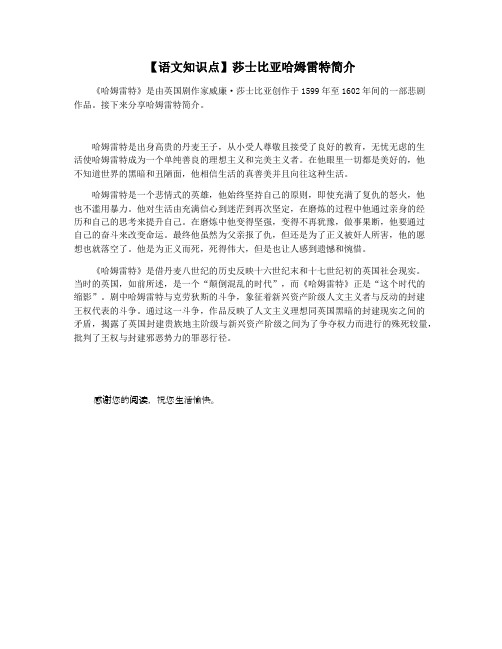
【语文知识点】莎士比亚哈姆雷特简介
《哈姆雷特》是由英国剧作家威廉·莎士比亚创作于1599年至1602年间的一部悲剧
作品。
接下来分享哈姆雷特简介。
哈姆雷特是出身高贵的丹麦王子,从小受人尊敬且接受了良好的教育,无忧无虑的生
活使哈姆雷特成为一个单纯善良的理想主义和完美主义者。
在他眼里一切都是美好的,他
不知道世界的黑暗和丑陋面,他相信生活的真善美并且向往这种生活。
哈姆雷特是一个悲情式的英雄,他始终坚持自己的原则,即使充满了复仇的怒火,他
也不滥用暴力。
他对生活由充满信心到迷茫到再次坚定,在磨炼的过程中他通过亲身的经
历和自己的思考来提升自己。
在磨炼中他变得坚强,变得不再犹豫,做事果断,他要通过
自己的奋斗来改变命运。
最终他虽然为父亲报了仇,但还是为了正义被奸人所害,他的愿
想也就落空了。
他是为正义而死,死得伟大,但是也让人感到遗憾和惋惜。
《哈姆雷特》是借丹麦八世纪的历史反映十六世纪末和十七世纪初的英国社会现实。
当时的英国,如前所述,是一个“颠倒混乱的时代”,而《哈姆雷特》正是“这个时代的
缩影”。
剧中哈姆雷特与克劳狄斯的斗争,象征着新兴资产阶级人文主义者与反动的封建
王权代表的斗争。
通过这一斗争,作品反映了人文主义理想同英国黑暗的封建现实之间的
矛盾,揭露了英国封建贵族地主阶级与新兴资产阶级之间为了争夺权力而进行的殊死较量,批判了王权与封建邪恶势力的罪恶行径。
感谢您的阅读,祝您生活愉快。
英文莎士比亚哈姆雷特 hamlet

What a piece of work is a man
In reason In faculty In form and moving In action In apprehension
noble ✓ infinite ✓ express, admirable ✓ like angel ✓ like a god ✓
In reason In faculty In form and moving In action In apprehension
noble ✓ infinite ✓ express, admirable ✓
What a piece of work is a man
In reason In faculty In form and moving In action In apprehension
生存或毁灭 -- (朱生豪)
• 生存还是毁灭, 这是个值得考虑的问题: • 是否应默默的忍受坎苛命运之无情打击, • 还是应与深如大海之无涯苦难奋然为敌, • 并将其克服 • 此二抉择,究竟是哪个较崇高? • • 死即睡眠, 它不过如此! • 倘若一眠能了结心灵之苦楚与肉体之百患, • 那么, 此结局是可盼的!
17 Ophelia has been driven mad by her father’s death and Hamlet’s rejection of her. She got drowned.
Hamlet – executive summary
18 Hamlet muses on her death at Yorick’s grave
Powerpoint Shakespeare’s Hamlet
《哈姆雷特》读书笔记

《哈姆雷特》读书笔记
《哈姆雷特(Hamlet)》是由英国剧作家威廉·莎士比亚创作于1599年至1602年间的一部悲剧作品。
莎翁的《哈姆雷特》是一部经典的代表作。
这本书在表面情节上与历史的传说并没有多大的区别,讲的还是丹麦王子为父报仇的故事,其中充满了血腥暴力和死亡。
正如剧中人霍拉旭所说︰你们能够听到奸淫残杀,反常修理的行为,冥冥中的判决,意外的屠戮,借手杀人的狡计,以及陷入自害的结局。
曲折选宕的情节,紧紧围绕着复仇而展开。
哈姆雷特从德国的威登堡匆匆赶回国内,是来参加他父亲的葬礼的,使他不能理解的是,他未赶上父亲的葬礼,却目睹了母亲与叔叔克劳迪斯的婚礼,这已使哈姆莱特疑窦在心,加之夜晚在王宫城堡的露台上与父亲的亡魂相见,亡魂哀诉,这桩暴行是哈姆雷特的叔叔所为,并要他为父报仇。
至此,他开始了艰难的复仇历程,与克劳迪斯展开了你死我活的较量。
最终,向克劳迪斯发出了复仇之剑。
对于我们来说,是艰难而辛苦的一年,但也同样是充满了希望和创新发展的一年。
追求梦想的道路总是曲折而艰辛的,前行的路上,有不少人会放弃坚持和耐心,梦想对于他们来说也许只是最初的激情,而一次次的磨砺让留下来的你们更加坚韧和强大。
也正因为你们的留下,让我更加坚强与执着,同时也让我明白了你们的坚持才是我最大的财富.
谢谢你们!。
- 1、下载文档前请自行甄别文档内容的完整性,平台不提供额外的编辑、内容补充、找答案等附加服务。
- 2、"仅部分预览"的文档,不可在线预览部分如存在完整性等问题,可反馈申请退款(可完整预览的文档不适用该条件!)。
- 3、如文档侵犯您的权益,请联系客服反馈,我们会尽快为您处理(人工客服工作时间:9:00-18:30)。
Introduction
* As the greatest dramatist in the world
literature,Shakespeare is remembered by the entire world for centuries and his works are read, put onto the stage, loved and memorized with an intense passion.
2) “To die—to sleep/No more; … The heartache, and the thousand natural shocks /That flesh is heir to, …” :
“To die—to sleep” : To die is to sleep. “No more”: to die is to be no more. “The heartache, … That flesh is heir to ”: all kinds of sufferings (shocks) that naturally occur to human beings (“flesh”—human body); “natural shocks”: attacks made by nature.
“spurns”: insults, contempt, disdain.
“That … takes”: the people of endure at the hands of the unworthy.
“quietus”: the final settlement of an account.
I. TOPIC: Hamlet(Act 3, Scene 1, lines 55-86) II. OBJECTIVES: A) Introduction B) The main idea of “Hamlet” and its themes C) A study of the text
1. The main idea of Act 3, Scene 1 2. Key points 3. Stylistic features 4. Comment on “Hamlet” D) Assignment
The main idea of Act 3, Scene 1
1. to focus on the deep conflict within Hamlet. 2. open amid agitation and gloom. 3. Hamlet’s brooding. 4. father’s ghost. 5. to be torn between the demands of his emotions
The chief elements:
1.The stories of murder and revenge 2.The appearance of a ghost 3.The performance of a play within a play 4.Whether he was mad
Themes
3) “To die—to sleep. /To sleep—perchance to dream: ay, there’s the rub! /For in that sleep of death …/When we have shuffled off this mortal coil, /Must give us pause. ”:
and the hesitant skepticism of his mind. 6. to reveal this conflict in several famous and
eloquent soliloquies. 7. The “To be or not to be” soliloquy is central to Hamlet’s
comments.
Key points
1) “To be , or not to be—that is the question:/Whether ’tis nobler in the mind to suffer/The slings and arrows …fortune/Or to take arms against a sea of troubles,/And by opposing end them.
Further explana来自ion:Hamlet is depressed and disillusioned when he hears his mother’s hasty marriage to his uncle and his father’s being murdering. He feels everyone and everything is tainted so that he is torn between emotions and the hesitant skepticism of his mind. It can reveal Hamlet’s personality—the complex deep conflict.
“perchance”:maybe. “rub”:obstacle, impediment. Here it refers to the doubt or difficulty. “shuffled off this mortal coil” : end this life; “mortal coil”:turmoil of mortality, human life. “give us pause”:make us hesitate.
“The insolence of office”: the haughty and contemptuous behavior shown by holders of high governmental posts./ the contempt held by the people of high rank.
4) “There’s the respect /That makes calamity of so long life./For who would bear the whips and scorns of time, … /The insolence of office, and the spurns/That patient merit of th’ unworthy takes,/When he himself might his quietus make,/With a bare bodkin? ” :
“To be , or not to be—that is the question”: to live on in this world or to die; to suffer or to take action; to take action or to do nothing; to be:to exist. “in the mind to suffer”: passively to suffer “slings and arrows”: attacks. “to take arms against a sea of troubles”: to take up arms against troubles that sweep upon us like a sea. The “troubles” is pictured as advancing like some overwhelming tide.
* “Hamlet” is the first of the great tragedies, is generally regarded as Shakespeare’s most popular play on the stage and can be reckoned as the summit of all Shakespeare’s works.
* The story of “Hamlet” is about the revenge of Prince Hamlet, based on an old Danish legend of the 13th century widespread in northern Europe .
The main idea of “Hamlet”
Further explanation:
Hamlet here gives the reasons why he does not want to commit suicide. He feels hesitant to kill himself because he thinks that some terrible dreams may trouble him after his death.
1. the vengeance of a son 2. to die suddenly 3. the wedding 4. to brood 5. ghost’s appearance 6. to pretend to be mad 7. to estrange himself from his friends 8. the performance of a play within a play 9. sent him to England 10. Ophelia's death. 11. a fencing match 12. to drink the poisoned wine 13. to kill Claudius
